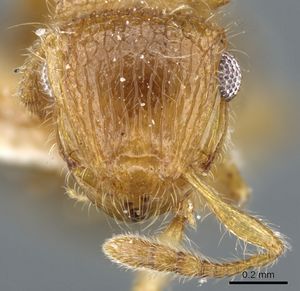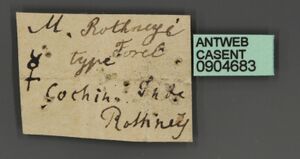Meranoplus rothneyi
| Meranoplus rothneyi | |
|---|---|

| |
| Scientific classification | |
| Kingdom: | Animalia |
| Phylum: | Arthropoda |
| Class: | Insecta |
| Order: | Hymenoptera |
| Family: | Formicidae |
| Subfamily: | Myrmicinae |
| Tribe: | Crematogastrini |
| Genus: | Meranoplus |
| Species: | M. rothneyi |
| Binomial name | |
| Meranoplus rothneyi Forel, 1902 | |
Identification
Schödl (1998) - This little species is generally well characterized by the promesonotal shield being provided only with a pair of posterior stout spines. In addition with the shape of the head and the clypeal traits it may be placed close to the widely distributed M. bicolor. Nevertheless, it is unmistakable with any congener throughout the range of its distribution.
The type material differs slightly from the remaining studied material from northern samples, the dorsum being less distinctly reticulate, the gaster being distinctly shagreened, and the lateral margins of promesonotum being margined conspicuously lamellate. The disjunct distribution (of the material, as studied yet) might indicate that there are two species. Nonetheless the studied material is here treated as one species, since differences are found among northern populations as well. Further material, particularly from the wide distribution gap is needed to determine, whether M. rothneyi consists of more than one species.
Keys including this Species
Distribution
Latitudinal Distribution Pattern
Latitudinal Range: 25.18333333° to 6.406°.
| North Temperate |
North Subtropical |
Tropical | South Subtropical |
South Temperate |
- Source: AntMaps
Distribution based on Regional Taxon Lists
Oriental Region: Bhutan, India (type locality), Nepal, Sri Lanka.
Distribution based on AntMaps
Distribution based on AntWeb specimens
Check data from AntWeb
Countries Occupied
| Number of countries occupied by this species based on AntWiki Regional Taxon Lists. In general, fewer countries occupied indicates a narrower range, while more countries indicates a more widespread species. |

|
Estimated Abundance
| Relative abundance based on number of AntMaps records per species (this species within the purple bar). Fewer records (to the left) indicates a less abundant/encountered species while more records (to the right) indicates more abundant/encountered species. |

|
Biology
Castes
Worker
Images from AntWeb
   
| |
| Syntype of Meranoplus rothneyi. Worker. Specimen code casent0904683. Photographer Z. Lieberman, uploaded by California Academy of Sciences. | Owned by MSNG, Genoa, Italy. |
Nomenclature
The following information is derived from Barry Bolton's Online Catalogue of the Ants of the World.
- rothneyi. Meranoplus rothneyi Forel, 1902c: 241 (w.) INDIA (Kerala).
- Type-material: lectotype worker (by designation of Schödl, 1998: 391), 2 paralectotype workers.
- Type-locality: lectotype India: Cochin (= Kerala, Kochi) (Rothney); paralectotypes with same data.
- Type-depositories: NHMB (lectotype); NHMW, MNHU (paralectotypes).
- [Note: Schödl, 1998: 391, says type-material of this taxon is not present in Forel’s collection at MHNG.]
- Status as species: Forel, 1903a: 706; Bingham, 1903: 170; Forel, 1907a: 12; Forel, 1912b: 82; Emery, 1924d: 228; Teranishi, 1940: 67; Chapman & Capco, 1951: 113; Bolton, 1995b: 251; Schödl, 1998: 391 (redescription); Tiwari, 1999: 62; Mathew & Tiwari, 2000: 333; Bharti & Akbar, 2014c: 814 (in key); Bharti, Guénard, et al. 2016: 38; Dias, R.K.S. et al. 2020: 77.
- Distribution: Bhutan, India, Nepal, Sri Lanka.
Unless otherwise noted the text for the remainder of this section is reported from the publication that includes the original description.
Description
Worker
Schödl (1998) - TL: 2.8 - 3.2, HL: 0.65 - 0.8, HW: 0.66 - 73 CI- 90 - 96 SL- 0.49 - 0.55, SI: 73 - 81, PML: 0.5 - 0.55, PW: 0.55 - 0.65, PMI: 1 10 - 130, AL- 6 - 0.73 (10 measured).
Mandibles striate, armed with four teeth. Mid-portion of clypeus oblique, slightly concave and smooth. Anterior clypeal margin produced into a very narrow apron. Mid-portion wun lateral cannulae, which run into short denticles in the antero-lateral comers the denticles conspicuously projecting forward, when viewed from the side. Frontal triangle apparent, partly carinulate. Head above antennal scrobes trapezoid, the lateral sides evenly narrowed towards clypeus; ventral part of head (below the antennal scrobes) much wider than dorsal part, somewhat more rectangular, the genae distinctly protruding when viewed from above. Antennal scrobes smooth, posteriorly occasionally shagreened and with transverse carinulae, the genae distinctly carinate to rugulose. Compound eyes situated well behind middle of lateral sides of head close to the occipital corners. Maximum diameter of eye 0.18 - 0.22, with 11-13 ommatidia in the longest row.
Promesonotum slightly wider than long, overhanging sides of alitrunk laterally and propodeum posteriorly. Lateral margins of promesonotal shield evenly narrowed towards posterior mesonotal corners. At about the level of (invisible) promesonotal suture with a more or less distinct constriction (excavation on each side), followed by a blunt denticle, which may be almost reduced (type material). In that area the lateral margins occasionally lamellate and translucent. Posterior comers of mesonotum produced into stout, posteriorly directed spines of variable size. Propodeum distinctly overhung by the lamella between posterior mesonotal spines. Declivity of propodeum smooth, with few longitudinal rugae or carinulae above. In about middle of its length propodeum provided with two slender, posteriorly projecting lateral spines.
Petiole in lateral view cuneate, in dorsal view the crest a line. Anterior and posterior petiolar faces smooth. Postpetiole nodiform in lateral view. First gastral tergite shagreened (type material), or smooth with a very indistinct shagreening.
Dorsum of head anteriorly longitudinally carinulate to reticulate-rugulose on lateral sides, reticulate posteriorly near occiput, width of meshes ca. 30 - 60 μm, sometimes with a faint secondary shagreening. Promesonotal shield reticulate-rugulose above, the reticulation more developed than on dorsal head, width of meshes ca. 30 - 70 jam. Postpetiole covered with rugae and wrinkles. All dorsal surfaces covered with short and dense, decumbent to suberect pubscence (ca. 80-120 μm) and longer stiff, suberect to erect, outstanding hairs (ca. 150 - 250 μm). Colour brightly ferrugineous (type material; probably callow worker) to darker brown, sometimes slightly bicoloured, with the gaster darker than remaining body parts.
Type Material
Schödl (1998) - In Forel's collection (Musee d'Histoire Naturelle Genève) this species is not present. I worker (number of syntypes unknown) (Naturhistorisches Museum, Basel) is here fixed as lectotype: "M. Rothneyi type Forel Cochin Indes (Rothney) \ Sammlung Dr. F. Santschi Kairouan"; 1 paralectotype (Naturhistorisches Museum Wien, Vienna): "Rothneyi Forel, Type. \ Cochinchina [!sic; typing error] CoIl. G.Mayr \ M. Rothneyi <;> Forel Cochin (Inde (Rothney)". One (?) syntype worker, "Indien (Cochin) Rothney \ Meranoplus rothneyi Forel \ Paratypus \ Forel det. 1922 [!] \ Zool. Mus. Berlin" (Berlin Museum für Naturkunde der Humboldt-Universität).
References
- Dendup, K.C., Dorji, C., Dhadwal, T., Bharti, H., Pfeiffer, M. 2021. A preliminary checklist of ants from Bhutan. Asian Myrmecology 14, e014005 (doi:10.20362/am.014005).
- Forel, A. 1902c. Myrmicinae nouveaux de l'Inde et de Ceylan. Rev. Suisse Zool. 10: 165-249 (page 241, worker described)
- Schödl, S. 1998. Taxonomic revision of Oriental Meranoplus F. Smith, 1853 (Insecta: Hymenoptera: Formicidae: Myrmicinae). Ann. Naturhist. Mus. Wien. B. Bot. Zool. 100: 361-394 (page 391, see also)
- Subedi, I.P., Budha, P.B., Bharti, H., Alonso, L. 2020. An updated checklist of Nepalese ants (Hymenoptera, Formicidae). ZooKeys 1006, 99–136 (doi:10.3897/zookeys.1006.58808).
- Yodprasit, K., Buddhakala, N., Tasen, W., Jaitrong, W. 2024. Two new species and a new record of the ant genus Meranoplus Smith, 1853 (Hymenoptera, Formicidae, Myrmicinae) from Thailand. ZooKeys 1210, 207–227 (doi:10.3897/zookeys.1210.125990).
References based on Global Ant Biodiversity Informatics
- Bharti H. 2001. Check list of ants from north-west India I. Uttar Pradesh Journal of Zoology 21(2): 163-167.
- Dad J. M., S. A. Akbar, H. Bharti, and A. A. Wachkoo. 2019. Community structure and ant species diversity across select sites ofWestern Ghats, India. Acta Ecologica Sinica 39: 219–228.
- Forel A. 1912. Einige interessante Ameisen des Deutschen Entomologischen Museums zu Berlin-Dahlem. Entomol. Mitt. 1: 81-83.
- Ghosh S. N., S. Sheela, B. G. Kundu, S. Roychowdhury, and R. N. Tiwari. 2006. Insecta: Hymenoptera: Formicidae. Pp. 369-398 in: Alfred, J. R. B. (ed.) 2006. Fauna of Arunachal Pradesh. (Part -2). [State Fauna Series 13.]. New Delhi: Zoological Survey of India, iv + 518 pp.
- Gumawardene, N.R., J.D. Majer and J.P. Edirisinghe. 2008. Diversity and richness of ant species in a lowland wet forest reserve in Sri Lanka. Asian Myrmecology 2:71-83
- Gunawardene N. R., J. D. Majer, and J. P. Edirisinghe. 2008. Diversity and richness of ant species in a lowland wet forest reserve in Sri Lanka. Asian Myrmecology 2: 71-83.
- Raci N., C. Sravanthy, C. Sammaiah, and M. Thirupahaiah. 2015. Biodiversity of ants (Insecta-Hymenoptera) in agroecosystem and grass land in Jammikunta, Karimnagar District, Telangana, India. Journal ofEnvironment 4(1): 11-16.
- Schodl S. 1999. Description of Meranoplus birmanus sp. nov. from Myanmar, and the first record of M. bicolor from Laos (Hymenoptera: Formicidae). Entomological Problems 30(2): 61-65.
- Schödl S. 1998. Taxonomic revision of Oriental Meranoplus F. Smith, 1853 (Insecta: Hymenoptera: Formicidae: Myrmicinae). Annalen des Naturhistorischen Museums in Wien. B, Botanik, Zoologie 100: 361-394.
- Tiwari R.N., B.G. Kundu, S. Roychowdhury, S.N. Ghosh. 1999. Insecta: Hymenoptera: Formicidae. Pp. 211-294 in: Director; Zoological Survey of India (ed.) 1999. Fauna of West Bengal. Part 8. Insecta (Trichoptera, Thysanoptera, Neuroptera, Hymenoptera and Anoplura). Calcutta: Zoological Survey of India, iv + 442 pp.

